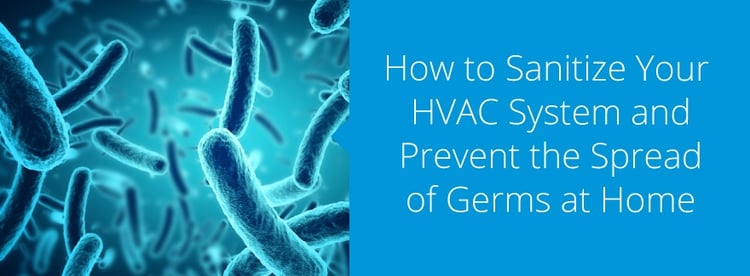
Everyone wants to be healthy and keep their family healthy. However, not everyone realizes the risk that HVAC-borne germs can pose for their loved ones. Efforts to combat HVAC germs in hospitals have drawn media attention because antibiotic-resistant germs have begun to appear in the air in hospitals and because hospitals are designed to house people who are sick and thus contagious.
- Keep Air Circulating When Possible
- Control Humidity Levels in Your Home
- Use Ultraviolet Light
- Invest in Air Filtration
- Keep Areas Around HVAC Equipment Clean
- Simple Ways to Clean Your HVAC System
Consider these statHealthcare Facilities Today: Healthcare-associated infections (HAIs) kill more people in the United States than AIDS. Experts argue that airborne versions of these diseases are the most dangerous and are on the rise in the United States.

That being said, what do HAIs have to do with the need to reduce home germs in an HVAC system?
While the risks to your HVAC system may not be as serious as those facing hospitals and healthcare facilities, the same principals apply. In other words, there is a lot to learn from hospitals and healthcare facilities about why it’s important to keep your HVAC system sanitized.
In fact, there are some things you can do to reduce the potential for an airborne infection from being transmitted through your HVAC system. During periods of increased airborne disease risk such as flu season, this work is especially important. This instructional guide offers the best ways to reduce home bacteria in your HVAC system.
Keep Air Circulating When Possible
Innovations in HVAC technology have made it easier and more energy-efficient to keep our homes cooler in the summer and warmer in the winter, but that kind of environmental control comes at a cost.
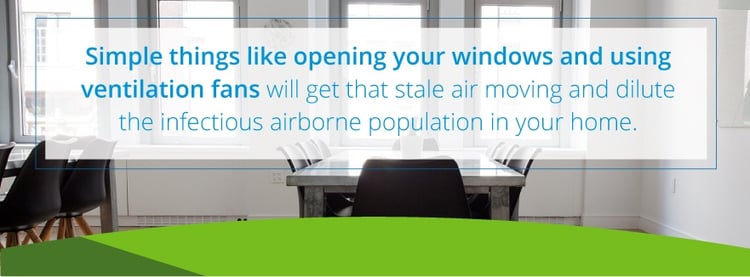
Unfortunately, when you are relying solely on HVAC systems for temperature control, you are increasingly relying on recycled air. That means that as germs enter your home, they aren’t being removed. Simple things like opening your windows and using ventilation fans will get that stale air moving and dilute the infectious airborne population in your home.
It’s worth noting that moving air can make you more comfortable even at a higher temperature. Not only does a summer cross-breeze in your home work like a fan, but it also helps reduce humidity, making your home feel cooler. Prevent the spread of germs at home by cracking a window now and again.
Even if it is warmer out than the temperature you would normally set on your thermostat, consider turning off the AC and opening a few windows. Even if you only do this in the evening, you will drastically improve the air quality of your home.
Control Humidity Levels in Your Home
The winter is considered flu season for many reasons. First and foremost, you spend more time indoors and in places where airborne germs can easily concentrate. Another contributing factor is the lack of humidity in the air.

As CNN points out, humidity levels in the winter in America can often drop as low as 10%, the same humidity levels in the Sahara Desert.

Since the flu and other viruses survive more easily in low humidity environments, creating a more moderate humidity in your home can keep you and your family healthier.
CNN reports a growing consensus of scientists suggest that homes with an ambient humidity between 40% and 60% have fewer flu germs in the air and on surfaces such as sinks and countertops. In fact, getting the humidity in your home to these levels can reduce the survival rate of flu viruses by up to 30%.
From a comfort standpoint, increasing the winter humidity in your home can reduce dry, itchy skin while combatting respiratory problems such as nosebleeds. That’s why so many people install portable humidifiers in their bedrooms every winter, but increasing humidity could also serve as your first line of defense against the flu.
To create the perfect balance, you want to be more aggressive than just plugging in a humidifier every night.
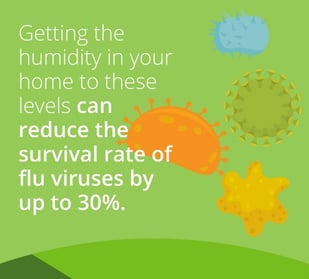
Start by purchasing a hygrometer. They are available at most home improvement stores and can be easily found online. This tool will help you know the exact atmospheric humidity levels in your home. Next, invest in a humidifier that is appropriate for the room size and designed with germ-prevention in mind.
Remember, many entry-level humidifiers can harbor their own germs. That’s why manufacturers have been creating models with built-in filters and UV germ-killing features. In some homes, a portable single-room humidifier may not do enough. Homes with open floor plans or that have large rooms are notoriously difficult to humidify. Even if portable humidifiers are insufficient, you do have options.
Whole-home humidifiers have become increasingly popular. Rather than generating water vapor on a room-by-room basis, a whole-home humidifier adds moisture to the air in your ductwork. They have the added benefit of making your house feel warmer without needing to crank the thermostat. They are also far more energy-efficient than a fleet of single-room humidifiers.
If you are ready to make your home more inhospitable for the flu virus, consider starting with winter humidifier solutions. With so many benefits beyond reducing the flu virus, it’s a great first step.
Use Ultraviolet Light
Although most Americans are unaware of the power of ultraviolet (UV) light for the purposes of combatting airborne germs, there is a long history to this approach. Back in 1903, UV light was used as a means of combatting the virus that causes tuberculosis. Since then, it has been used effectively in places requiring sterile work environments, especially medical facilities.
However, the type of UV light required for germ killing was expensive to produce, so it didn’t become a common feature outside of commercial applications. Only UV-C light does the job, and these wavelengths don’t occur on earth very easily, as the ozone layer prevents UV-C light from penetrating our atmosphere.
But all that is changing. The technology is getting cheaper, so a lot of people are adding disinfecting UV light as a redundancy in combination with other sanitizing procedures. In fact, these types of lights have become more popular in restaurants throughout the country. You may have even noticed it — a strange blue light in the corner of a restaurant kitchen as you were ordering your food is likely a germ-killing UV light.
There are many home HVAC applications that utilize UV light to improve air quality.

The first is a wand-like device that allows you to shine the disinfecting UV light on surfaces you want to address. This is especially useful if the surface you are disinfecting is challenging for other cleaning solutions, such as fabrics and couches or computer keyboards. However, while they are great tools, they are not effective when it comes to addressing airborne germs.
Luckily, you can also introduce UV technology into your HVAC system. This is done by installing a direction UV-C light at the air mover that is pushing either cooled or heated air throughout your home. That way, as air circulates throughout your home, you will simultaneously be sending the air through an effective disinfecting apparatus.
Make sure that, if you have a humidifier installed, it has a UV-C light within the device. This will help make sure your humidifier doesn’t become a breeding ground for the very germs you are trying to combat!
It is also worth noting that a UV-C disinfecting light is an effective tool year-round. While humidifiers are a great tool during the flu season, germs can infect your home during the summer as well. It offers yet another layer of protection for you and your family.
Invest in Air Filtration
While we already noted that recycled air is more prone to airborne germs, there are times during the year, especially in the middle of winter or summer, that opening the windows just isn’t practical. It is in those moments that air filtration becomes so important.
Though no one wants to open a window in summer or winter, it’s in the winter when the lack of humidity already makes the air conducive to infections like the flu. Considering how dry air keeps getting recycled again and again as it flows through your furnace, it can quickly be filled with germs. Luckily, there are air filtration products designed for just these issues.

Similar to portable humidifiers, single-room air purifiers can be purchased that greatly reduce the number of airborne particle and germs floating in your air. Several times per hour, these filters will take the air of the room and pass it through a highly-effective particulate filter.
Look for a filter that comes with a High-Efficiency Particulate Air (HEPA) filter. Doctors and allergists prefer these as they are the most effective air purification tools available. They are essentially mats of randomly arranged fiberglass fibers, somewhere between 0.5 and 2.0 micrometers. While most people assume HEPA filters work like a sieve, this is incorrect. HEPA filters are capable of catching particles that are much smaller than the space between fibers. Instead, these particles stick to the fibers as they pass over them.
Air filtration is also a good option for allergy sufferers. Not only will a HEPA filter remove microbes such as the flu or cold virus, but it will also remove dust, mites, pollen and other allergens. Like humidifiers, air filtration can either be accomplished on a room-by-room basis or centrally for your whole home.
Individual room filtration is nice because it allows you to be flexible with where you use it. If you only want to address air quality in a couple of rooms, this is also the more affordable option. However, by opting for centralized air filtration, you take advantage of some big leaps in technology.
All HVAC systems use some filtration to remove particulates from the intake ductwork that pulls air back from your home, which is cycled through either the furnace or the air conditioning. These filters need to be regularly replaced.
However, there are more sophisticated centralized filtration systems that will do far more than a simple replaceable air filter. Many centralized air filtration symptoms meet the same stringent requirements of hospital air filtration system. Hospitals are extremely vigilant about airborne HAIs, so you know this technology is going to be effective.
Furthermore, if you want to include your whole house within your air filtration system, this is the most cost-effective way to do so. While it is more expensive than individual air filtration devices, it will save on energy and replacement costs in the long run.
Look out for Critters
If you live in an older home, it is likely that uninvited guests, whether they are rodents or insects, have stopped by from time to time. Not only are these critters a nuisance, but they can also bring disease. While an invader might enter through a hole in your siding or be found in your cupboards, they can also make their invasion through your ductwork.
If you do find a mouse, ants or some other unwanted pests, seek out an exterminator. Not only will they set up traps or spray chemicals to drive off or kill the pests, but they will discover the way by which the critters entered in the first place and ensure they no longer have a way to enter your home.
If the pests entered through your ductwork, you will need to hire an HVAC professional to address the issue. While repairs may be a hassle, vermin often return through the same means they first used to enter your home. Infestations will be a regular occurrence until the issue is repaired.
Keep Areas Around HVAC Equipment Clean
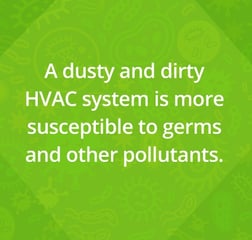 A dusty and dirty HVAC system is more susceptible to germs and other pollutants. One of the best ways to keep dust out of your ductwork is to keep the area around both your furnace and your central air conditioning unit clean.
A dusty and dirty HVAC system is more susceptible to germs and other pollutants. One of the best ways to keep dust out of your ductwork is to keep the area around both your furnace and your central air conditioning unit clean.
Keeping a furnace clean is especially challenging in an older home with an unfinished basement. Years of dust can collect while old stone foundations flake and create more debris. That’s why you want to regularly use a shop vacuum and make sure the area around the furnace is as clean as possible.
Air conditioners use both outdoor and indoor equipment. While the air filtering through your duct work doesn’t come into contact with the outdoor portion of your unit, it does come in contact with the indoor evaporator coil. This is usually placed in the same area as your furnace. So, you need to take the same care with keeping the evaporator coil clean.
If you have window air conditioners, cleanliness is especially important. Window units pull outside air and push it through a refrigerator unit. If the interior workings of a window unit become dirty, they can also harbor germs. Refrigerating coils create condensation, causing water to collect and therefore giving germs a comfortable place to multiply.
Look out for Water Damage
There is another risk that comes with running the AC: water damage. While the risks posed by water damage aren’t contained within the HVAC system, they can be caused by a malfunctioning HVAC system. Water damage, especially in drywall or wood studs, can produce mold. Some molds, especially black mold, can cause severe health risks.
If you do see water damage being caused by your HVAC system — or anything else for that matter — get the damage repaired right away. This involves more than simply covering unsightly stains with paint, which don’t fix the problem. Patches of drywall that have been damaged need to be removed.
If the damage is being caused by an HVAC leak, then that also needs to be fixed right away or else the damage will just return. Plus, the best time to address the issue is while replacing drywall, as it will likely expose the cause of the problem.
Use Ventilation When Showering
During the summer, excess humidity can become a problem. Mold and bacteria like damp environments. One way to control humidity is to ventilate the air when you are creating steam in your home. This is most often done in the bathroom every time you shower. While many people use ventilation fans, they are often seen as a convenience to ensure the bathroom mirror isn’t fogged over after they step out of the shower.
But, during the summer, venting the steam will keep your home more comfortable and healthy.
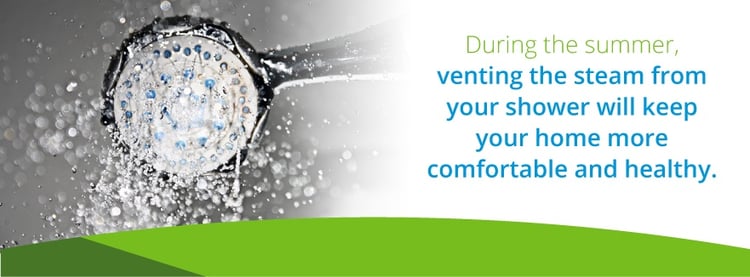
While you’re at it, consider taking a shorter shower. The longer you are in the shower, the more steam you will be producing. While ventilation can remove a large portion of that humidity, it won’t remove it all. A shorter shower will decrease the humidity still left in your home’s atmosphere when you are done.
Proper ventilation and short showers are simple solutions that can go a long way in improving the air quality in your home.
Simple Ways to Clean Your HVAC System
When it comes to sanitizing your HVAC system, it's essential to regularly clean and maintain your equipment. Routine cleaning is the key to keeping your unit performing at full capacity — ultimately prolonging your HVAC system's lifespan, lowering electricity costs and eliminating the need for repairs.
With the right tools, disinfectants and know-how, HVAC system cleaning can be easy. Follow along with these simple steps to ensure the cleanliness and functionality of your unit.
Clean or Replace Filters
It's usually a good idea to replace your filters every three months or so to make sure they're successfully trapping particles and contaminants. Just make sure you know your filter's dimensions to ensure that you purchase the correct size for your HVAC system. Once you have your new filter, reattach it by aligning the arrow located on the outer edge of the screen with the direction of airflow.
If your filter doesn't need to be replaced but could still use some sanitation, simply remove the filter and rinse it off on a monthly basis.
Clean Vents and Registers
Your air vents and floor registers are essential in generating airflow throughout your home. However, these components tend to collect excess dirt, dust and debris.
Luckily, there's a variety of ways you can rid your registers of gunk and grime. The simplest of these techniques is to lift up the registers, wipe them down and vacuum each vent as thoroughly as possible. You can also use the vacuum hose or a long-handle brush to loosen up the dirt and clean those hard-to-reach spaces in your HVAC system's return air registers.
Please note that you should not use Lysol to sanitize your HVAC system's return vents. Lysol has a high ethanol alcohol concentration, which means it is highly flammable. When you spray this disinfectant into your HVAC system, it could come into contact with the electric motor and create a flash explosion that could damage your home's ductwork and even create a fire. It is crucial that you avoid using Lysol as an HVAC system sanitizer.
Clean the Air Ducts
Next, it's important to disinfect your air ducts. Start by using a screwdriver to unfasten the air duct covers and grilles. First, you can clean the grates with a cloth, then use your vacuum hose to remove dust in corners and tight spaces. You can even purchase a heavy-duty vacuum for extra cleaning power. Lastly, be sure to swab the insides of the ducts with a brush to eliminate mold and mildew.
Other HVAC System Cleaning Tips
Once you've cleaned the main parts of your HVAC system, consider disinfecting these other areas of the unit:
- Inspect and clean the surrounding area: Remove any leaves, grass or branches that could potentially grow into the system.
- Clean the condensing part: Spray the outer component of the unit with water.
- Clean the drainage hole: Use a small piece of wire or a paperclip to clean at the base of the cabinet.
- Clean the evaporator coil: Dust the inside with a soft brush, then spray the coil with coil cleaner.
- Clean the blower compartment: Be cautious around the furnace fan while vacuuming out debris.
- Reset your thermostat: Set your thermostat to temperatures that are conducive to your preferences and accommodate your schedule.
Receive Regular HVAC Service
Finally, if you want your HVAC system to be as germ-free as possible, regular maintenance is important.
For example, leaky air conditioners and stagnant water can create mold issues while also serving as a breeding ground for bacteria. A hidden leak will be identified during routine maintenance and repaired promptly, meaning that this concern can be avoided.
Furthermore, if you have added central filtration or humidifiers, you also have more moving parts to be addressed. Filtration especially requires regular maintenance. Much of that can be done by the homeowner — such as the replacement or cleaning of filters — but you also want to make sure you have it professionally serviced from time to time. Remember, these tools are highly-effective, but only if they are in peak operational condition.
Moreover, regular maintenance will also include system cleaning. Cleaning an HVAC system thoroughly is challenging, and it often requires pulling equipment apart. While a homeowner can certainly do some of this work on their own, completing the job is most easily done by a professional.
This is especially important in air conditioning units. One of the trouble spots for germs in an AC unit is the condensate drain. If this drain backs up, then condensate collects, creating a stagnant pool of water. Germs love this type of environment. Regular maintenance checks include an inspection of the condensate drain as well as a cleaning of evaporator coils.
Partner With Smart Touch Energy
Regardless of where you live, you can follow these helpful air quality tips to ensure your HVAC system isn’t becoming a germ factory. If you live in New Jersey, New York, Delaware, Maryland, Pennsylvania, Connecticut, Massachusetts, New Hampshire, Maine or Rhode Island, your best solution for HVAC service is Smart Touch Energy.
The company began as a heating oil company, committed to taking the hassle out of buying heating oil. However, as our reputation for peerless service and fair pricing grew, we expanded our service to include regular HVAC maintenance.
Our service includes a full-service cleaning, one of the most important actions you can take to combat germs in your HVAC system. Our air conditioning maintenance includes a thorough cleaning of both your condensate drain and evaporator coil, both of which are essential for keeping your HVAC system germ free.
If you have questions about cleaning your HVAC unit, need regular maintenance or a piece of your HVAC equipment requires service, contact us today.




